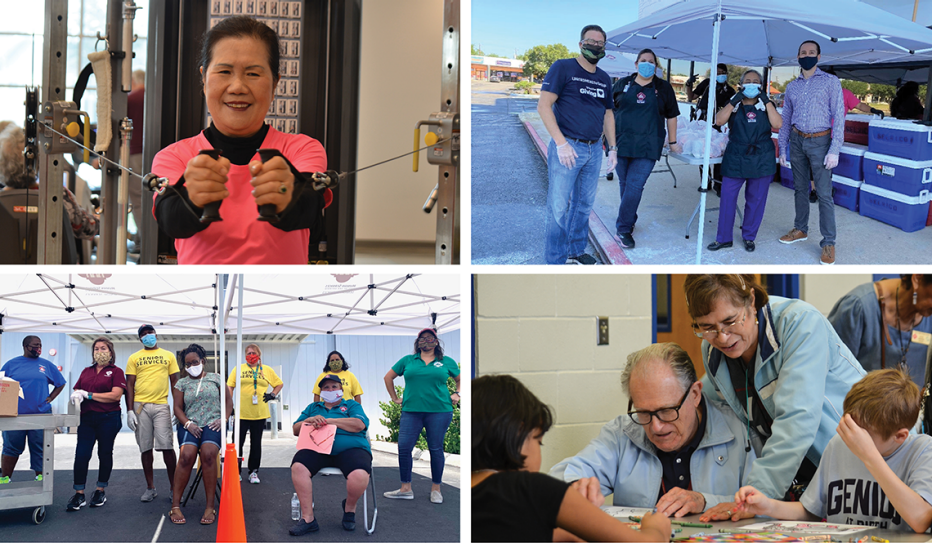AARP Hearing Center


The Community
Fast-growing San Antonio, Texas, is home to 1.5 million people and is the seventh largest city in the United States and second largest in Texas. A racially diverse community, San Antonio's population is 64 percent Hispanic, 24.8 percent white non-Hispanic, 7 percent African American and 3 percent Asian. The total population age 60 or older is roughly 17 percent. San Antonio joined the AARP Network of Age-Friendly States and Communities in 2014 and reaffirmed its commitment in 2017.
Community Representative
- Jessica Dovalina, Assistant Director, Department of Human Services, City of San Antonio
Partner Organizations
- Alamo Area Council of Governments
- Bexar Senior Advisory Committee
- Bihl Haus Arts
- City of San Antonio and Bexar County Joint Commission on Elderly Affairs
- Good Samaritan Community Services
- Meals on Wheels of San Antonio
- San Antonio Area Foundation
- San Antonio Food Bank
- San Antonio OASIS
- Successfully Aging and Living in San Antonio (SALSA)
- Urban-15
- United Way of San Antonio and Bexar County
- WellMed Charitable Foundation
- YMCA of Greater San Antonio
- YWCA San Antonio
Equity Focus
- Adapting to meet the evolving demand for senior center services and utilizing an equity-based approach to location decisions for future senior centers
- Integration of equity-based, age-friendly policy action across municipal departments
- Equity-based decision-making, programming and budgeting
The Work
Jessica Dovalina describes the city government's commitment to ensuring older adults are healthy, engaged and independent by fostering an equitable, age-friendly community.
Planning for Equity
“In 2019, we used the age-friendly community framework — alongside other planning efforts centered on older adults — to inform a review of city senior services, location decisions for future senior centers and the integration of age-friendly policy actions across multiple city departments and programs," says Dovalina. "We gathered and disaggregated insights from community and senior center members to ensure that our work reflected the specific needs identified by our diverse residents."
Through the planning process, the city developed multi-year goals, prioritizing equity-based investments in the 8 Domains of Livability. "The goal of our programming and services is to support the ability of older adults to remain healthy, safe, independent and thriving in our community," Dovalina adds.
Implementing the Plan, Measuring Equitable Impact
In Fiscal Year 2020, the city evaluated how its programming and services were meeting the interests and needs of the community. Data was reviewed by gender, race, age and income to ensure that senior center programming has an equitable approach to serving the community’s most vulnerable populations. With 10 comprehensive senior centers and 42 part-time community-operated nutrition sites, the culture, environment and services offered at each center are tailored to meet the needs of the community each one serves.
"The Department of Human Services works closely with other city departments and community stakeholders to assess program and service utilization so we can understand if our older residents are experiencing barriers to accessing these services," Dovalina says.
The coordination of the work includes the City of San Antonio and Bexar County Joint Commission on Elderly Affairs, funders, service providers and San Antonio seniors to align city implementation strategies and, to the extent possible, community efforts to enhance equity-based programming and services that make San Antonio a city where seniors can age well and in place.
Our Path Forward
"COVID-19 has made a lasting impact on San Antonio and the organizations serving our residents," says Dovalina. "Food insecurity, social isolation risk and the potential increases of elder fraud and abuse heightened the visibility of health and quality-of-life inequities. Although our senior services adapted quickly to meet immediate food and other resource needs, the disparities highlighted by the pandemic have intensified our efforts to deliver equity-focused programs and policies."
The city has also adopted equity-based decision-making practices and budgeting. (See the equity tool link below.) Explains Dovalina: "These processes will help to ensure that city departments allocate resources, develop programs and champion community-based strategies that address San Antonio's disparities and inequities.”
Related Resources
AARP Links
- Learn about the AARP Network of Age-Friendly States and Communities
- Check out the network's Member List
- Connect with AARP Texas
- Find Age-Friendly Responses to COVID-19
Read about another community: Age-Friendly Network Communities and Equity
Reported by Mary Kay Bailey | Fall 2020 | Population data from the U.S. Census































































